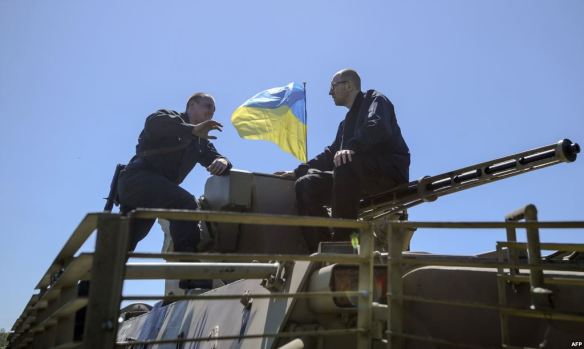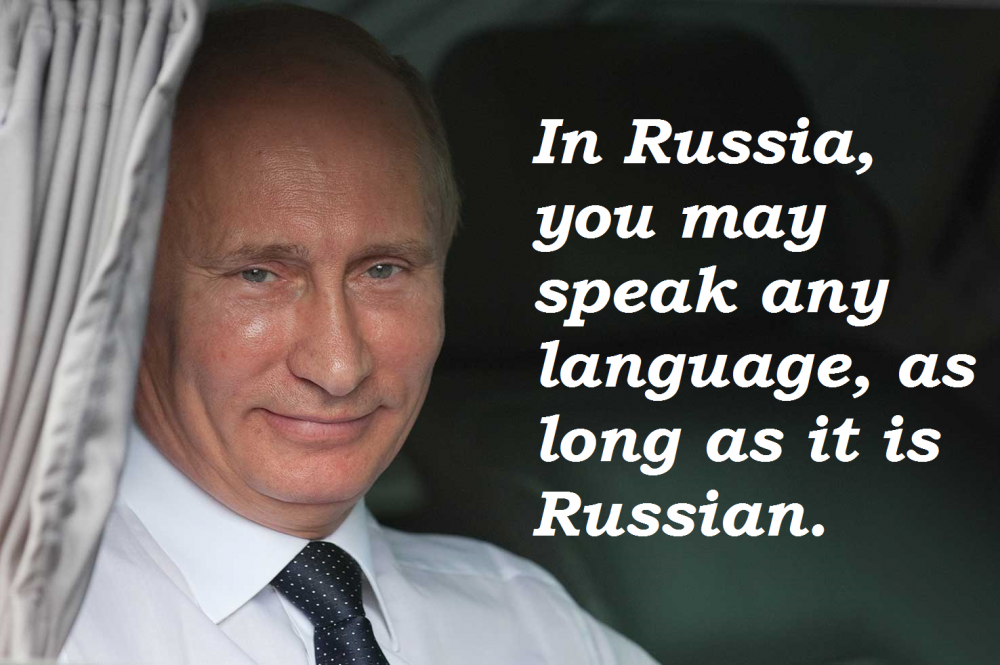
Ihor Losyev, Radio Svoboda, May 22, 2014
The events in Crimea and now in the Donbas have shown that the security forces of Ukraine have turned out to be ineffective and nonfunctional. A few wits have called Ukraine's security forces "slabovyky" (the weak ones -- Ed.). The issue is not only the organizational, financial, and human resource aspects of such a sorry state, but above all its ideological-educational one -- how, for a period of 20 years, a peculiar version of the army, the Security Service and the Interior Ministry was being created. The army, in fact, has remained a fragment of the Soviet army, an offspring of the Russian-Soviet military tradition. Additionally, it is significant that during the entire educational-training process, particular emphasis was placed on the so-called "shared" Soviet-Russian military history and heroics. The examples of the USSR and Russia were constantly imposed; what was specifically Ukrainian was marginalized.
The inexperienced person would even find it difficult to distinguish between the Russian and Ukrainian military uniforms, since the Armed Forces of Ukraine based their uniforms on the Soviet model, with minor changes. This, too, is important -- the defenders of the country need to have their own form of dress. However, they actually tried to avoid differing too much from their Russian colleagues, as if the Ukrainian army was only a local version of the Russian one.
Despite all the rhetoric of Euro-Atlantic integration, somehow aggression was expected from the West and not the East, and, therefore, the troops were oriented in that direction. There was a void in the East, since that is where the supposed "strategic partner" was located. It has been reported that as many as 93 soldiers of the Armed Forces of Ukraine were stationed in the Luhansk Oblast.
The entire country was made to believe that there was no threat to Ukraine, and certainly not from the "brotherly state," even though any thinking person could not fail to understand that there was no enemy more dangerous for Ukraine than the former metropolis, where not only the top government authorities but also the general population continue to dream of imperial revenge.
To have some idea of this reality it was enough to watch Russian telecasts and read Russian newspapers, especially since there is no shortage of them in Ukraine. From the beginning, it was clear that sooner of later Russia would attempt to attack Ukraine. The only question was when exactly.
What ideology?
The security forces of Ukraine were held captive by this ideology of "friendship with Russia," even though in Russia, by contrast, malicious social concepts and mass sentiments regarding Ukraine prevailed . Furthermore, the anti-Ukrainian propaganda gathered momentum ever since the time of Kuchma and the Tuzla island conflict*. The "friendship" ideology has long been a psychological weapon for the Kremlin, but notably it has never prevented it from acting against Ukraine. However, this ideology has always kept Ukraine from defending itself.
Ukraine's government, contrary to all the facts, imposed this ideology in various ways on the army and navy. For example, it forced admirals of the Ukrainian Navy to embrace their Russian counterparts and continued to depict something that did not exist in reality. After all, from the very beginning of the formation of the Ukrainian Navy in 1992, the Russians usually exhibited hostility to their Ukrainian colleagues. The Ukrainian military, however, continued to be inculcated with idealistic notions of "unbreakable brotherhood," "Russian-Ukrainian unity," common roots" and other inventions of political mythology. Even the secret services collaborated much too closely -- so closely in fact that during the regime of Yanukovych and his SBU (Security Service of Ukraine) chief Yakymenko, Ukrainian patriots sarcastically labeled the SBU, the FSB-U (FSB is the Russian Federal Security Service -- ED.).As one wise man noted accurately: "There can be friendly states, but not friendly intelligence services."
In contrast, the Russian officer corps never bought into this "friendly" demagoguery, and its behavior during the aggression against Ukraine in 2014 has proven it.
The cult of the "great patriotic war" was imposed on the armed forces of Ukraine -- the last myth of the Kremlin great power ideology, which continues to be fully protected by Russian authorities even if it requires criminal prosecution. It must be understood that the myth of the "great patriotic war" works exclusively to serve the Kremlin's imperial interests. It never worked for Ukraine, Moldova, the Baltic states, the Caucasus, and it will not work since it is fully exploited by Moscow to create a powerful ideological machine for geopolitical expansion and the division of Europe into spheres of influence. Therefore, the Ukrainian army was being raised on the ideology of another country -- not its own. This is why Soviet-Russian -- not Ukrainian -- patriotism was being formed in the Armed Forces of Ukraine without any acknowledgement that Ukrainians have their own history, their own place in Europe and the world, and are an independent nation, not an a mere add-on for Russians.
How it happened
From the perspective of ideological strategy, the entire system of educating the security services of Ukraine was flawed. Many military units in Ukraine have retained the Soviet military awards, names, and flags, which were designed to celebrate the military victories of another country's armies and to retain ideological continuity with it. The glorification of Stalin's marshals, generals, and admirals, the naming in their honor of military schools of an independent Ukraine also played a role in the process of denationalization of the Armed Forces. It is precisely during the period of independence that that the busts of Stalin's generals Zhukov and Vatutin appeared in the Defense Ministry building. Somehow space could not be found for the busts of the Ukrainian National Republic or the UPA (Ukrainian Insurgent Army). The Ukrainian Army never emancipated itself from the Russian-Bolshevik heritage, and the presence of this heritage has fed the hopes of Moscow's empire restorers for the easy incorporation of Ukraine into Russia.
Ukrainian troops were being persuaded that Soviet history is their history, that the Soviet army is their army, and therefore that the rightful successors of this army are their brothers and allies. It is this ideological scheme that made the resistance of Ukrainian military units in Crimea in February-March of 2014 practically impossible. The Ukrainian army had been ideologically corrupted beforehand by fables of "unbreakable Ukrainian-Russian friendship." An ideologically corrupted army is incapable of fighting.
Therefore, we must reach fundamental conclusions today, especially regarding radical changes in the training of the personnel of the army and the other security forces. Everything in this sphere must be based on the teaching of Ukrainian patriotism, and this cannot be done on the basis of an inferiority complex regarding the nation, the country, and the army, or on the basis of the "junior partner" complex, as the assistant to the senior Russian "brother." Such education inevitably forms a human capital that Vasyl Stus called "a nation of sergeants."
The Army of Ukraine today turned out to be exactly the kind that during all these years of independence the higher political leadership of the country trained it to be, with worker-officers, "parquet" generals, hungry soldiers, and a complete lack of understanding why this army even exists.
*Territorial dispute over the ownership of the island between Ukraine and Russia in October 2003.
by Ihor Losyev, Ph.D., Associate Professor of Cultural Anthropology, National University of Kyiv-Mohyla Academy
Translated by Anna Mostovych
Original Ukrainian Source: http://www.radiosvoboda.org/content/article/25394470.html


